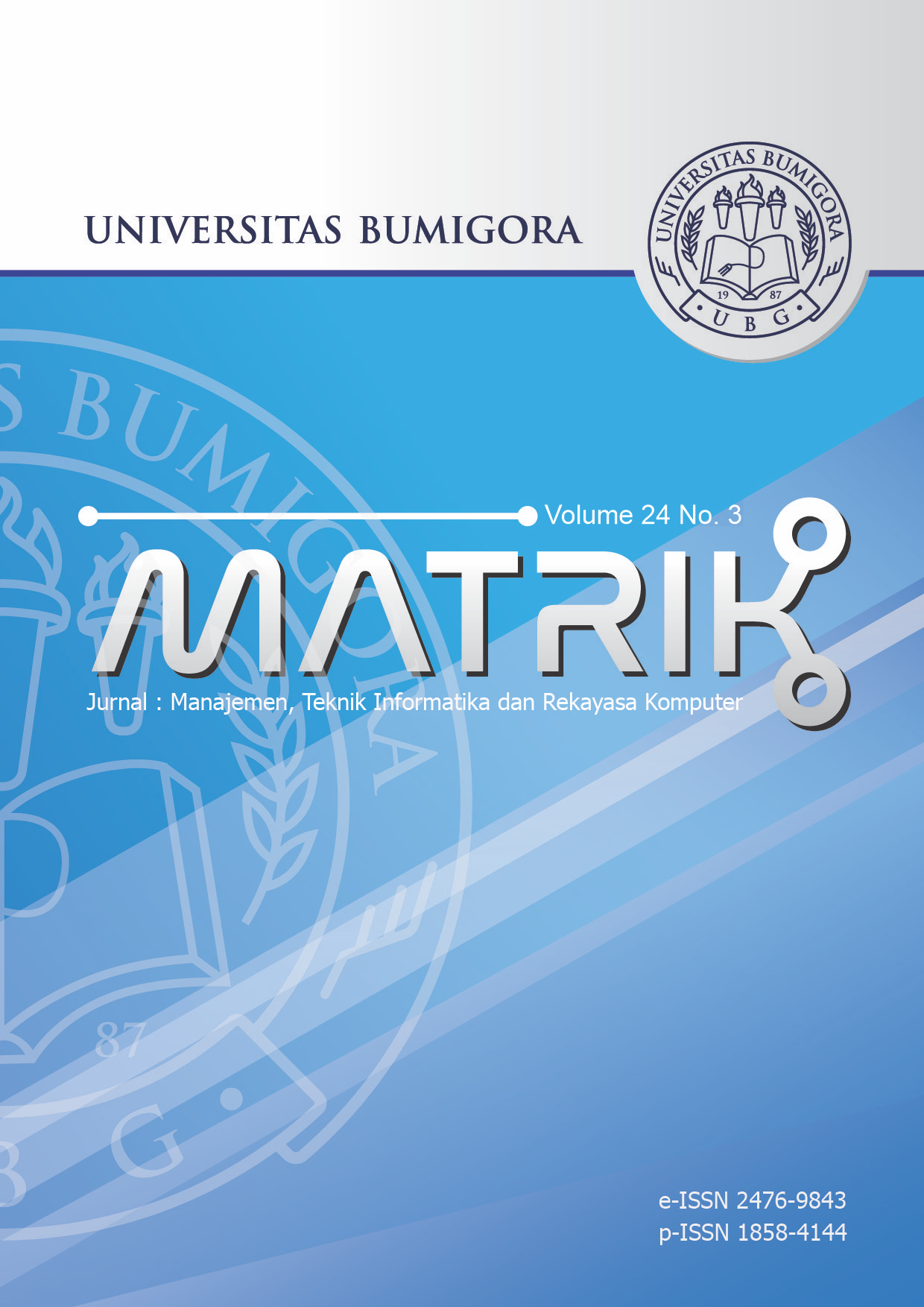Comparison of Random Forest Support Vector Machine and Passive Aggressive Models on E-nose-Based Aromatic Rice Classification
DOI:
https://doi.org/10.30812/matrik.v24i3.4291Keywords:
Aromatic Rice, Electronic Nose, Passive Aggressive, Random Forest, Support Vector MachineAbstract
Accurate classification of aromatic rice types is crucial for maintaining quality and meeting consumer preferences. The purpose of this study is to classify MentikWangi, PandanWangi, and C4 rice based on their volatile content using e-nose. C4 rice, as a popular non-aromatic variety, was included as a comparison for sensor response analysis. The research method involved preprocessing the e-nose gas sensor readings, including feature extraction, baseline manipulation, and missing value checking, to ensure data quality. The classification was performed using Random Forest, Support Vector Machine, and Passive-Aggressive methods. The results showed that the Random Forest model achieved the highest accuracy of 97%, followed by the Support Vector Machine at 95% and Passive Aggressive at 90%. The model evaluation utilized a Confusion Matrix and Receiver Operating Characteristics, which confirmed that Random Forest was the best-performing model. This study concludes that e-nose-based classification effectively differentiates between aromatic rice types, providing significant potential for objective and efficient quality assessment and offering valuable insights for further research in areas such as food technology, agricultural science, and chemical analysis.
Downloads
References
[1] Y. Xiong, X. Zheng, X. Tian, C. Wang, J. Chen, L. Zhou, D. Xu, J. Wang, V. Gilard, M. Wu, and A. You, “Comparative study
of volatile organic compound profiles in aromatic and non-aromatic rice cultivars using HS-GC–IMS and their correlation with
sensory evaluation,” LWT, vol. 203, july, p. 116321, 2024, https://doi.org/10.1016/j.lwt.2024.116321.
[2] A. Akwero, D. Ocan, W. Akech, J. Lamo, M. Ochwo-Ssemakula, and P. Rubaihayo, “Allelic variations in aroma gene in
cultivated rice varieties,” African Crop Science Journal, vol. 28, no. 2, pp. 241–254, Jul. 2020, https://doi.org/10.4314/acsj.
v28i2.9.
[3] X. Lu, X. Cai, and S. Liu, “Application of practical bionic electronic nose in rice wine detection,” in 2ND International
Conference on Frontiers Of Biological Sciences and Engineering (FSBE 2019), Jinan City, China, 2020, p. 020035,
https://doi.org/10.1063/5.0000313.
[4] A. J. Moshayedi, A. Sohail Khan, J. Hu, A. Nawaz, and J. Zhu, “E-Nose-Driven Advancements in Ammonia Gas Detection:
A Comprehensive Review from Traditional to Cutting-Edge Systems in Indoor to Outdoor Agriculture,” Sustainability, vol. 15,
no. 15, p. 11601, july 2023, https://doi.org/10.3390/su151511601.
[5] E. Kartikadarma, S. Wijayanti, S. A. Wulandari, and F. A. Rafrastara, “Principle Component Analysis for Classification of the
Quality of Aromatic Rice,” september 2020, https://doi.org/10.48550/arXiv.2009.06496.
[6] Z. Ye, Y. Liu, and Q. Li, “Recent Progress in Smart Electronic Nose Technologies Enabled with Machine Learning Methods,”
Sensors, vol. 21, no. 22, p. 7620, november 2021, https://doi.org/10.3390/s21227620.
[7] R. Ruslan, S. Khairunniza-Bejo, I. Rukunudin, M. Jahari, and M. Ibrahim, “Development of a machine vision system for rice
seed inspection system,” Food Research, vol. 4, no. S6, pp. 150–156, Dec. 2020, https://doi.org/10.26656/fr.2017.4(S6).049.
[8] A. Aznan, C. Gonzalez Viejo, A. Pang, and S. Fuentes, “Rapid Assessment of Rice Quality Traits Using Low-Cost Digital
Technologies,” Foods, vol. 11, no. 9, p. 1181, Apr. 2022, https://doi.org/10.3390/foods11091181.
[9] A. A. Munawar and Z. Sabaruddin, “Fast classification of rice (Oryza sativa) cultivars based on fragrance and environmental
origins by means of near infrared spectroscopy,” IOP Conference Series: Earth and Environmental Science, vol. 644, no. 1, p.
012003, january 2021, https://doi.org/10.1088/1755-1315/644/1/012003.
[10] M. H. Alsharif, A. H. Kelechi, K. Yahya, and S. A. Chaudhry, “Machine Learning Algorithms for Smart Data Analysis in
Internet of Things Environment: Taxonomies and Research Trends,” Symmetry, vol. 12, no. 1, p. 88, Jan. 2020, https://doi.org/
10.3390/sym12010088.
[11] N. A. Isaac, I. Pikaar, and G. Biskos, “Metal oxide semiconducting nanomaterials for air quality gas sensors: operating principles,
performance, and synthesis techniques,” Microchimica Acta, vol. 189, no. 5, p. 196, 2022, https://doi.org/10.1007/
s00604-022-05254-0.
[12] B. Sumanto, D. R. Java, W. Wijaya, and J. Hendry, “Seleksi Fitur Terhadap Performa Kinerja Sistem E-Nose untuk Klasifikasi
Aroma Kopi Gayo,” MATRIK : Jurnal Manajemen, Teknik Informatika dan Rekayasa Komputer, vol. 21, no. 2, pp. 429–438,
march 2022, https://doi.org/10.30812/matrik.v21i2.1495.
[13] S. Dhanekar, “Smart and Intelligent E-nose for Sensitive and Selective Chemical Sensing Applications,” in Smart Sensors for
Environmental and Medical Applications, 1st ed., H. Hallil and H. Heidari, Eds. Wiley, april 2020, pp. 149–171, https:
//doi.org/10.1002/9781119587422.ch8.
[14] E. S. A. Nugraha, N. D. Resty, Y. I. T. Wijaya, and B. Sumanto, “Electronic Nose to Classify Tobacco Origin using a Naive
Bayes Method based on Feature Selection,” in 2023 International Conference on Computer Science, Information Technology
and Engineering (ICCoSITE). Jakarta, Indonesia: IEEE, february 2023, pp. 267–272, https://doi.org/10.1109/ICCoSITE57641.
2023.10127800.
[15] D. R. Prehanto, A. D. Indriyanti, I. K. D. Nuryana, and G. S. Permadi, “Classification based on K-Nearest Neighbor and Logistic
Regression method of coffee using Electronic Nose,” IOP Conference Series: Materials Science and Engineering, vol. 1098,
no. 3, p. 032080, march 2021, https://doi.org/10.1088/1757-899X/1098/3/032080.
[16] S. Wakhid, R. Sarno, S. I. Sabilla, and D. B. Maghfira, “Detection and Classification of Indonesian Civet and Non-Civet Coffee
Based on Statistical Analysis Comparison Using E-Nose,” International Journal of Intelligent Engineering and Systems, vol. 13,
no. 4, pp. 56–65, augustus 2020, https://doi.org/10.22266/ijies2020.0831.06.
[17] S. Tangirala, “Evaluating the Impact of GINI Index and Information Gain on Classification using Decision Tree Classifier
Algorithm*,” International Journal of Advanced Computer Science and Applications, vol. 11, no. 2, pp. 612–619, 2020, https:
//doi.org/10.14569/IJACSA.2020.0110277.
[18] N. Kunhare, R. Tiwari, and J. Dhar, “Particle swarm optimization and feature selection for intrusion detection system,” S¯adhan¯a,
vol. 45, no. 1, p. 109, december 2020, https://doi.org/10.1007/s12046-020-1308-5.
[19] X. Kan and T. Li, “Slant Split Criterion Random Forests Classification Algorithm based on Soft Margin Hyperplane,” in 2020
IEEE 9th Joint International Information Technology and Artificial Intelligence Conference (ITAIC). Chongqing, China: IEEE,
december 2020, pp. 1332–1337, https://doi.org/10.1109/ITAIC49862.2020.9339073.
[20] B. Sumanto, I. Nathasya, W. Wijaya, and J. Hendry, “Aplikasi Electronic Nose Untuk Klasifikasi Kopi Aceh Gayo Berdasarkan
Proses Pasca Panen,” Jurnal Teknologi dan Sistem Komputer, vol. 11, no. 1, 2024, https://doi.org/10.14710/jtsiskom.2023.
14421.
[21] P. Lemberger and I. Panico, “A primer on domain adaptation theory and applications,” ArXiv, no. M1, 2020.
[22] V. Shabani, A. Havolli, A. Maraj, and L. Fetahu, “Fake News Detection using Naive Bayes Classifier and Passive Aggressive
Classifier,” in 2023 12th Mediterranean Conference on Embedded Computing (MECO). Budva, Montenegro: IEEE, june
2023, pp. 1–6, https://doi.org/10.1109/MECO58584.2023.10155036.
[23] R. Muzzammel and A. Raza, “A Support Vector Machine Learning-Based Protection Technique for MT-HVDC Systems,”
Energies, vol. 13, no. 24, p. 6668, december 2020, https://doi.org/10.3390/en13246668.
[24] A. A. H. De Hond, E. W. Steyerberg, and B. Van Calster, “Interpreting area under the receiver operating characteristic curve,”
The Lancet Digital Health, vol. 4, no. 12, pp. e853–e855, december 2022, https://doi.org/10.1016/S2589-7500(22)00188-1.
[25] B. Sumanto, Y. Idianingrum Tw, S. Humaira, R. Lestari Budiani, and M. Arrofiq, “E-nose Application With Chemometrics
for Monitoring Kombucha Tea Fermentation Process,” JST (Jurnal Sains dan Teknologi), vol. 12, no. 1, march 2023, https:
//doi.org/10.23887/jstundiksha.v12i1.50994.
[26] M. Riadi, A. M. Okasa, R. Sjahril, and M. Mahendradatta, “Volatile Compound Analysis of Aromatic Rice Mutant Lines Using
HS-SPME/GC-MS,” Jurnal Bioteknologi & Biosains Indonesia, vol. 9, no. 2, pp. 257–267, 2022.
Downloads
Published
Issue
Section
License
Copyright (c) 2025 Budi Sumanto, Salima Nurrahma

This work is licensed under a Creative Commons Attribution-ShareAlike 4.0 International License.
How to Cite
Similar Articles
- Yuri Ariyanto, Yan Watequlis Syaifudin, M. Hasyim Ratsanjani, Ali Ridho Muladawila, Triana Fatmawati, Pramana Yoga Saputra, Chandrasena Setiadi , Cyber Threat Detection and Automated Response Using Wazuh and Telegram API , MATRIK : Jurnal Manajemen, Teknik Informatika dan Rekayasa Komputer: Vol. 25 No. 1 (2025)
- Neny Sulistianingsih, Galih Hendro Martono, Enhancing Predictive Models: An In-depth Analysis of Feature Selection Techniques Coupled with Boosting Algorithms , MATRIK : Jurnal Manajemen, Teknik Informatika dan Rekayasa Komputer: Vol. 23 No. 2 (2024)
- Muhammad Amirul Mukminin, Tio Dharmawan, Muhamad Arief Hidayat, Gender Classification Using Viola Jones, Orthogonal Difference Local Binary Pattern and Principal Component Analysis , MATRIK : Jurnal Manajemen, Teknik Informatika dan Rekayasa Komputer: Vol. 23 No. 3 (2024)
- Bakhtiyar Hadi Prakoso, Implementasi Support Vector Regression pada Prediksi Inflasi Indeks Harga Konsumen , MATRIK : Jurnal Manajemen, Teknik Informatika dan Rekayasa Komputer: Vol. 19 No. 1 (2019)
- Rahmaddeni Rahmaddeni, M. Teguh Wicaksono, Denok Wulandari, Agustriono Agustriono, Sang Adji Ibrahim, Enhancing Multiple Linear Regression with Stacking Ensemble for Dissolved Oxygen Estimation , MATRIK : Jurnal Manajemen, Teknik Informatika dan Rekayasa Komputer: Vol. 24 No. 1 (2024)
- Lalu Zazuli Azhar Mardedi, Fahry Fahry, Miftahul Madani, Hairani Hairani, Detection of Rice Diseases Using Leaf Images with Visual Geometric Group (VGG-19) Architecture and Different Optimizers , MATRIK : Jurnal Manajemen, Teknik Informatika dan Rekayasa Komputer: Vol. 25 No. 1 (2025)
- Helen Sastypratiwi, Yulianti Yulianti, Hafiz Muhardi, Desepta Isna Ulumi, Incorporating User Experience Evaluation into Application Design for Optimal Usability , MATRIK : Jurnal Manajemen, Teknik Informatika dan Rekayasa Komputer: Vol. 22 No. 3 (2023)
- Helna Wardhana, I Made Yadi Dharma, Khairan Marzuki, Ibjan Syarif Hidayatullah, Implementation of Neural Machine Translation in Translating from Indonesian to Sasak Language , MATRIK : Jurnal Manajemen, Teknik Informatika dan Rekayasa Komputer: Vol. 23 No. 2 (2024)
- Firman Noor Hasan, Achmad Sufyan Aziz, Yos Nofendri, Utilization of Data Mining on MSMEs using FP-Growth Algorithm for Menu Recommendations , MATRIK : Jurnal Manajemen, Teknik Informatika dan Rekayasa Komputer: Vol. 22 No. 2 (2023)
- Erna Daniati, Sucipto Sucipto, Anita Sari Wardani, Akmal Hisyam Pradhana, Usability Test on the System Determination Decision Support ReleaseProduct Towards Contribution Level Decision Maker , MATRIK : Jurnal Manajemen, Teknik Informatika dan Rekayasa Komputer: Vol. 24 No. 3 (2025)
You may also start an advanced similarity search for this article.
Most read articles by the same author(s)
- Budi Sumanto, Denting Romantika Java, Wahyu Wijaya, Jans Hendry, Seleksi Fitur Terhadap Performa Kinerja Sistem E-Nose untuk Klasifikasi Aroma Kopi Gayo , MATRIK : Jurnal Manajemen, Teknik Informatika dan Rekayasa Komputer: Vol. 21 No. 2 (2022)


.png)












